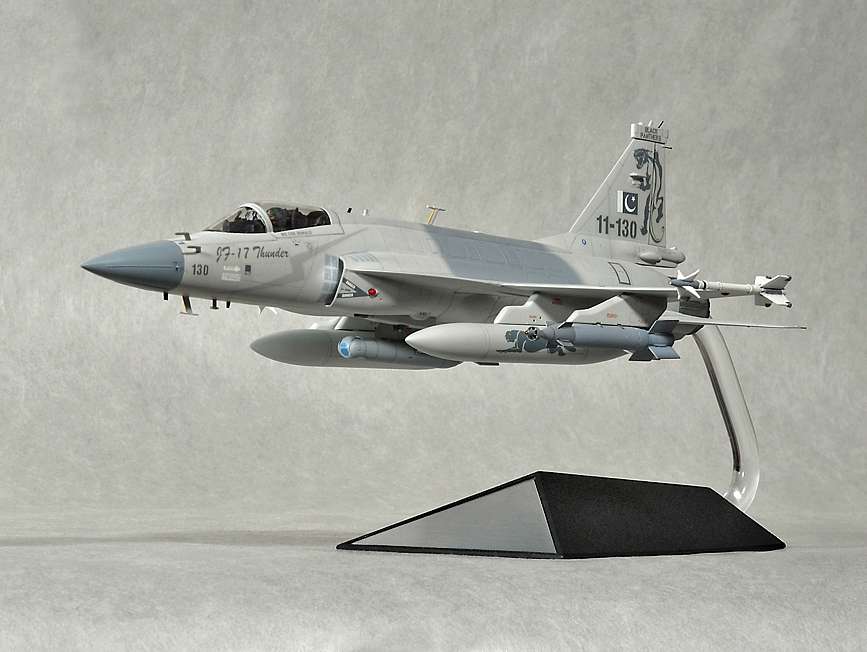JF-17 and Lca Tejas: Difference in approach
With 40 JF-17 aircrafts already inducted into Pakistan air force and Zero Tejas inducted in IAF, at least in papers JF-17 seems to be a successful project, but it is also clear that approach taken by IAF and PAF on LCA and JF-17 have been completely opposite to each other in terms of participation and acceptance levels of the aircraft.
For Pakistani air force JF-17 will be replacing aging A-5C, Mirage-III, Mirage-V, and F-7P/PG by 2015 and JF-17 is slated to become the backbone of Pakistan Airforce (PAF), JF-17 will also will be providing PAF next Gen technology, But for IAF Lca will not be bringing any new technology which it does not possess and will not be backbone or even lead secondary aircraft in future ,role of JF-17 and Tejas to their respected air force are different and also shows different approach taken by them .
PAF inducted JF-17 when it was capable only to carry PL-5EII WVR air to air missiles and fuel tanks over the time BVR missiles and other weapons were added to the aircraft; it took two years for PAF and Pakistani Aeronautical establishment to bring it to IOC standards. PAF already has Two Squadrons of JF-17 which are mostly used for carrying out such tests and for pilot conversion training.
IAF on other hand only agreed to accept 20 IOC-2 standard LCA and 20 more of FOC standards , while whole 40 JF-17 inducted by PAF are of IOC standards , this clearly shows IAF hesitance in inducting more LCA at its Initial stage , while PAF inducted larger number of JF-17 aircrafts with their IOC limitations . Both air forces have plans to induct close to 250 of such aircrafts in their fleet and approach taken by PAF will lead them to higher induction rate and better production line.
JF-17 has been developed in Blocks, first 40 aircraft which has already been delivered to PAF are of Block- I stage and first Block –II aircraft will likely be ready by end of this year or early next year and will come with ”enhanced features” like IFR, New ECM/data link, infra-red search and track (IRST) system and new weapons integration, PAF also has agreed to stick with Russian built Klimov RD-93 engines .Block II will incorporate features which PAF could not integrate with Block-I aircrafts leading to limited combat capabilities of JF-17 , Initial plans of Block-II aircrafts were to equip it with new WS-13 turbofan Chinese engine delivering higher thrust then current Russian engines and also equip it with an AESA radar , but now Block-III has been planned which will incorporate this features and plans are to have first aircraft ready by 2016 , Block-III will have reduced RCS and will feature twin seat variant and likely to have some stealth elements in the airframe .
While Tejas MK-2 which cannot be considered has another block variant, since MK-2 will feature new higher thrust engine, IFR, new mission computers, higher fuel and weapons carrying capacity and will also have different dimensions compared to Tejas MK-1 and first flight of Tejas MK-2 is expected by end of 2014 or early 2015, while FOC of Tejas MK-1 has been planned in 2014. Without any induction of MK-1 aircrafts, IAF forced development of MK-2 which has lead to delays and shift in focus for development of two variants of Tejas. PAF inducted JF-17 when it had not matured and suffered from technical deficiencies but brought standard of aircrafts in blocks to make it combat capable.
If IAF had agreed to more Tejas MK-1 in IOC standards, it could have helped starting and stabilizing production line for the aircraft. With limited orders for Tejas MK-1, aircrafts will be produced at slower rate and even Induction will be at much slower rate, while PAF with a stable production line will induct next 20 JF-17 of Block-II standard next year bringing total to 62 aircrafts while Tejas MK-1 handed over to IAF will only stand at 4.
JF-17 and Lca Tejas: Difference in approach | idrw.org













